Power BI Developer Updates – Embedded Analytics & Power BI Visuals Platform
At the beginning of November 2019, Microsoft introduced the capability to embed Power BI paginated reports in other applications. Microsoft’s September update for the Power BI Developer community brought a couple of new embed capabilities, automation & life-cycle management changes. However, the November update changelog is more extensive, with a total of 10 new and improved features being added to the service.
The following list covers all the changes that have been introduced as part of the latest update:
Embedded analytics updates
Automation & Life-cycle Management
- Connecting a report to datasets using dynamic binding
- Clone and rebindAPI An application program interface (API) is a set of routines, protocols, and tools for building software applications. Basically, an API specifies how software components should interact. Additionally, APIs are used when programming graphical user interface (GUI) components.
To get in-Depth knowledge on Power BI you can enroll for a live demo on Power BI online training
for generating embed token for multiple items
Embed Capabilities
- Embedded paginated reports
- Embedded AI – decomposition tree
- Automatic page refresh supported in Power BI embedded
- Personalize your table and matrix hyperlinks behavior
- Interact with your embedded mobile report with a single tap
- Bootstrap is a free and open-source CSS framework directed at responsive, mobile-first front-end web development. It contains CSS- and JavaScript-based design templates for typography, forms, buttons, navigation, and other interface components.your iframe to improve rendering performance
Power BI Visuals Platform Updates
- Context menu support
Embedded Analytics
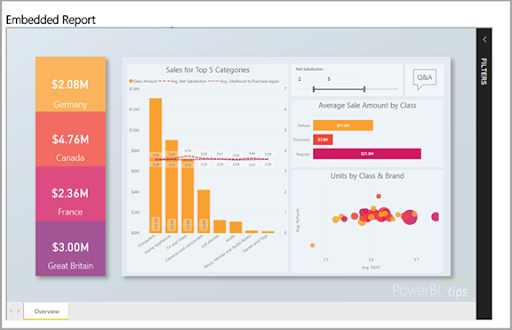
Connecting a Report to Datasets Using Dynamic Binding
While
connecting a report to a dataset, you can use dynamic binding. The
connection between the report and the dataset is known as binding. When
embedding a Power BI report using dynamic binding, you can connect the
same report to different datasets depending on the user’s credentials.
It
is aimed at software vendors and developers that have multiple
customers and users, each having their own unique workspace including a
dataset connected to a Power BI report. This speeds up the process of
maintaining hundreds of reports, Instead of copying and maintaining
hundreds of report duplicates. The latest now lets developers maintain a
single template of a report that can be connected to multiple datasets
across workspaces.
The same report displays
different information, depending on the dataset it is connected to. For
example, a report showing retail sales values can be connected to
different retailer datasets, and produce different results, depending on
the dataset of the retailer it is connected to. This is great as it
removes the need for manual intervention before sending out a report.
Clone and Rebind APIs Support Shared Datasets
Shared
datasets are now supported across all embedding solutions, manage
connections of Power BI datasets and reports across workspaces. Now with
this update you can clone and rebuild with the following
API
An application program interface (API) is a set of routines, protocols,
and tools for building software applications. Basically,
an API specifies how software components should interact.
Additionally, APIs are used when programming graphical user interface
(GUI) components.
- Rebind reportREST APIREST API Representational state transfer is a software architectural style that defines a set of constraints to be used for creating Web services.allows rebinding a report to a dataset across workspaces, replacing the need to create and maintain many datasets and fulfilling to maintain one report.
- Clone reportREST APIREST API Representational state transfer is a software architectural style that defines a set of constraints to be used for creating Web services.allows copying reports across workspaces while maintaining the original connection with the dataset that resides in a different workspace.
API for Generating Embed Token for Multiple Items
API An
application program interface (API) is a set of routines, protocols,
and tools for building software applications. Basically,
an API specifies how software components should interact.
Additionally, APIs are used when programming graphical user interface
(GUI) components.
enables embedding Power BI
content into applications for their customers and users. Generate an
embed token with permissions for multiple reports, datasets, and target
workspaces. Reports and datasets do not have to be related and binding
of a report to a dataset can be done during embedding.
The
API An
application program interface (API) is a set of routines, protocols,
and tools for building software applications. Basically,
an API specifies how software components should interact.
Additionally, APIs are used when programming graphical user interface
(GUI) components.
for generating embed token for multiple
items have the advantages for users, other than supporting shared
dataset related automation scenarios and dynamic binding. Implementation
and management when embedding multiple items reports drill through, and
improved performance when switching between reports.
Embedded Paginated Reports
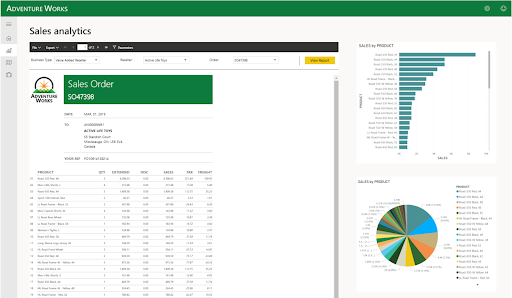
Embedding paginated reports into your apps and portals is now generally available.
Decomposition Tree Visual
A
decomposition tree can use to perform root-cause analysis by viewing
how individual categories in a group contribute to the whole. The visual
lets you break down, a group to see its individual categories and how
they can be ranked according to a selected measure.
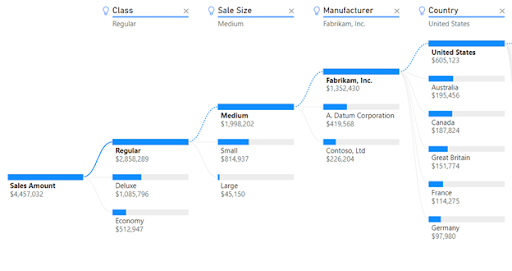
Automatic Page Refresh Supported in Power BI Embedded
The
automatic page refresh for DirectQuery for Power BI Desktop is now
public. Monitoring events with Power BI Embedded now refreshes data as
soon as the data source gets updated. You can now set the refresh
interval of visuals in your report when using a
DirectQuery is a type of connection in Power BI which does not load data into Power BI model.
source. For real-time reports, this will allow you to monitor time-critical data and ensure that they are always the latest.
Enabling the feature and setting the minimum refresh interval is the same for
Power
B is a cloud-based solution that makes use of the available data to
perform business analysis and helps share the results among the
organization easily to derive actionable items.
Embedded
Azure
Microsoft Azure With a comprehensive suite of cloud products, Microsoft
Azure, a platform as a service (PaaS), helps its users to create and
host enterprise-class solutions by collaborating with Microsoft’s
products. The best part of Microsoft Azure is that its users can build
and host solutions with having to build their own infrastructure.
capacities and Power BI Premium capacities.
How to Enable the Feature
First, you must enable the automatic page refresh feature in Power BI Desktop. Go to File > Options and settings then select Options, and select Preview features from the left pane. Enable the feature by selecting the checkbox beside the Automatic page refresh. An automatic page refresh is available only for DirectQuery data sources.
To use an automatic page refresh, select the report page for which you want to enable refresh. In the Visualizations pane, select the Formatting icon and find Page refresh near the bottom of the pane.
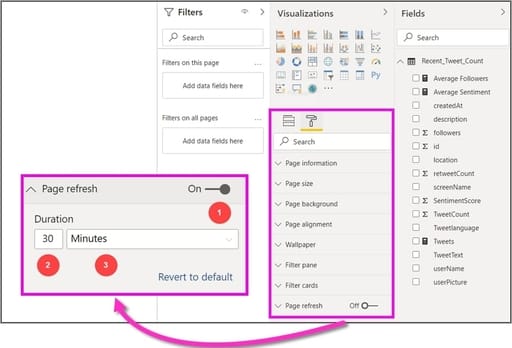
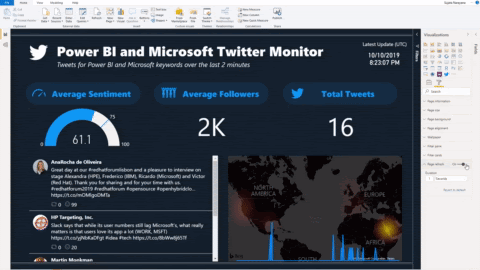
Personalize your Table and Matrix Hyperlinks Behavior
New
user action event, ‘dataHyperlinkClicked’. Power BI supports hyperlink
columns. When clicking on a hyperlink cell in a table or matrix native
visuals, the URL will be loaded into a new browsing context.
With ‘dataHyperlinkClicked’ event, application owners can control
hyperlink cell click behavior, by setting report embed configurations to
raise an event and provide their custom event handler. The event
contains the selected URL, and the click source – report, page and
visual.
Interact with your Embedded Mobile Report with Single Tap
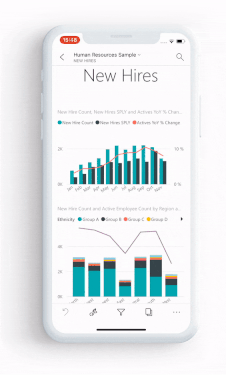
This feature is supported in the Power BI added support for mobile
Embedded analytics Embedded
analytics is the integration of analytic content and capabilities
within business process applications. It provides relevant information
and analytical tools designed so users can work smarter and more
efficiently in the applications they use every day.
within our
partners and customers’ applications. With a single tap interaction, a
visual is selected and the desired action is executed at the same time.
Take your career to new heights of success with Power BI online training Hyderabad
Bootstrap your iframe to Improve Rendering Performance
The
new powerbi bootstrap(element,config) allows developers to start
embedding before all required parameters are available. The Bootstrap is
a free and open-source CSS framework directed at responsive,
mobile-first front-end web development. It contains CSS- and
JavaScript-based design templates for typography, forms, buttons,
navigation, and other interface components.
API prepares and initializes the iframe. When using the
Bootstrap
is a free and open-source CSS framework directed at responsive,
mobile-first front-end web development. It contains CSS- and
JavaScript-based design templates for typography, forms, buttons,
navigation, and other interface components.
API An application
program interface (API) is a set of routines, protocols, and tools for
building software applications. Basically, an API specifies how software
components should interact. Additionally, APIs are used when
programming graphical user interface (GUI) components.
, it is
still required to call powerbi bootstrap(element,config) on the same
HTML element. One of the use cases for this feature for example, is to
run the iframe
Bootstrap is a free and open-source CSS
framework directed at responsive, mobile-first front-end web
development. It contains CSS- and JavaScript-based design templates for
typography, forms, buttons, navigation, and other interface components.
and the back-end calls for embedding (for instance, generate embed token), in parallel. It is highly recommended to use the
Bootstrap
is a free and open-source CSS framework directed at responsive,
mobile-first front-end web development. It contains CSS- and
JavaScript-based design templates for typography, forms, buttons,
navigation, and other interface components.
API An
application program interface (API) is a set of routines, protocols,
and tools for building software applications. Basically,
an API specifies how software components should interact.
Additionally, APIs are used when programming graphical user interface
(GUI) components.
when it is possible to generate the iframe before it is visible to the end user.
Power BI Visuals Platform
New Context Menu Support
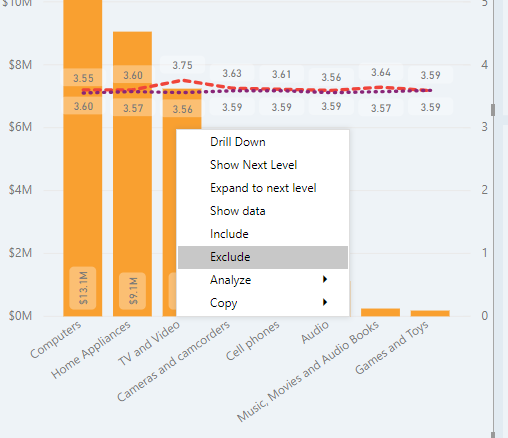
In
November’s update, Visual options menu and Context menu extensions were
added for embedded scenarios. Power BI visuals have two menus: Context
menu and the Options menu. The options menu is opened by clicking the
ellipsis icon on the top corner of the visual. The context menu is
opened by right click/hover on the data. Both menus can now be extended
to add customized actions specific to your app and users.
How to add a Context Menu to a Power BI Visual
You
can use selectionManager.showContextMenu() with parameters selectionId
and a position (as an {x:, y:} object) to have Power BI display a
context menu for your visual.
To add a simple right-click event (or long-press for touch devices) Context-Menu here is a sample BarChart for reference:
public update(options: VisualUpdateOptions) {
//...
//handle context menu
this.svg.on('contextmenu', () => {
const mouseEvent: MouseEvent = d3.event as MouseEvent;
const eventTarget: EventTarget = mouseEvent.target;
let dataPoint = d3.select(eventTarget).datum();
this.selectionManager.showContextMenu(dataPoint? dataPoint.selectionId : {}, {
x: mouseEvent.clientX,
y: mouseEvent.clientY
});
mouseEvent.preventDefault();
});

Comments
Post a Comment